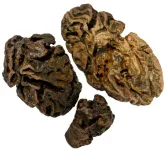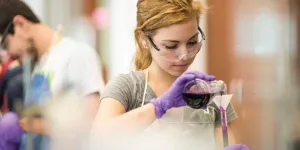(Press-News.org) Soft tissue preservation in the geological record is relatively rare, and, except where deliberate intervention halts the process of decay (like embalming or freezing), the survival of entire organs is particularly unusual. The spontaneous preservation of the brain in the absence of any other soft tissues - that is, the brain’s survival amongst otherwise skeletonised remains - has historically been regarded as a ‘one-of-a kind’ phenomenon.
A new study conducted by researchers at the University of Oxford, led by postgraduate researcher Alexandra Morton-Hayward (Department of Earth Sciences, Oxford), has challenged previously held views that brain preservation in the archaeological record is extremely rare. The team compiled a new archive of preserved human brains, which highlighted that nervous tissues actually persist in much greater abundances than traditionally thought, assisted by conditions that prevent decay. This global archive, drawing on source material in more than ten languages, represents the largest, most complete study of the archaeological literature to-date, and exceeds 20-fold the number of brains previously compiled.
This work, published today in the Proceedings of the Royal Society B, brings together the records of more than 4,000 preserved human brains from over two hundred sources, across six continents (excluding Antarctica). Many of these brains were up to 12,000 years old, and found in records dating back to the mid-17th century. Scouring the literature and canvassing historians worldwide, this concerted search revealed a bewildering array of archaeological sites yielding ancient human brains, including the shores of a lakebed in Stone Age Sweden, the depths of an Iranian salt mine around 500 BC, and the summit of Andean volcanoes at the height of the Incan Empire.
These shrunken, discoloured tissues were found preserved in all manner of individuals: from Egyptian and Korean royalty, through British and Danish monks, to Arctic explorers and victims of war.
Co-author, Professor Erin Saupe, Department of Earth Sciences, University of Oxford, said: “This record of ancient brains highlights the array of environments in which they can be preserved from the high arctic to arid deserts.”
Every brain in the database was matched with historic climate data from the same area, to explore trends in when and where they were found. The analyses revealed patterns in the environmental conditions associated with different modes of preservation through time - including dehydration, freezing, saponification (the transformation of fats to ‘grave wax’) and tanning (usually with peat, to form bog bodies).
Over 1,300 of the human brains were the only soft tissues preserved, prompting questions as to why the brain may persist when other organs perish. Interestingly, these brains also represent the oldest in the archive, with several dating to the last Ice Age. The mechanism of preservation for these oldest brains remains unknown; however, the research team suggest that molecular crosslinking and metal complexation – proteins and lipids fusing in the presence of elements like iron or copper - are feasible mechanisms by which nervous tissues might be preserved over long timescales.
Alexandra Morton-Hayward, lead author of the study, said “In the forensic field, it’s well-known that the brain is one of the first organs to decompose after death – yet this huge archive clearly demonstrates that there are certain circumstances in which it survives. Whether those circumstances are environmental, or related to the brain’s unique biochemistry, is the focus of our ongoing and future work. We’re finding amazing numbers and types of ancient biomolecules preserved in these archaeological brains, and it’s exciting to explore all that they can tell us about life and death in our ancestors.”
Co-author, Dr Ross Anderson, Department of Earth Sciences, University of Oxford, said: “These ancient brains provide a significant opportunity for unique insights into the early evolution of our species, such as the roles of ancient diseases.”
Finding soft tissues preserved is a bioarchaeologist’s treasure trove: they generally provide a greater depth and range of information than hard tissues alone, yet less than 1% of preserved brains have been investigated for ancient biomolecules. The untapped archive of 4,400 human brains described in this study may provide new and unique insights into our history, helping us to better understand ancient health and disease, and the evolution of human cognition and behaviour.
Notes to editors:
For media enquires and interview requests, contact Alexandra Morton-Hayward: alexandra.morton-hayward@earth.ox.ac.uk
Images of the preserved brains in the study are available via the following link: https://drive.google.com/drive/folders/1_bo0vg07AwLNXUV4eRqcgU5cOMsM_uSy?usp=sharing These are for editorial purposes only and must be credited. They must NOT be distributed to third parties.
The study ‘Human brains preserve in diverse environments for at least 12,000 years’ will be published in Proceedings of the Royal Society B: Biological Sciences at 00.01 GMT Wednesday 20 March / 20:01 ET Tuesday 19 March at https://royalsocietypublishing.org/doi/10.1098/rspb.2023.2606
To view a copy of the paper before the embargo lifts, contact Alexandra Morton-Hayward: alexandra.morton-hayward@earth.ox.ac.uk
The authors of the study and their affiliations are as follows:
Alexandra L. Morton-Hayward, Department of Earth Sciences, University of Oxford, UK; Target Discovery Institute, University of Oxford, UK; Department of Environmental Science, Aarhus University, Denmark
Ross P. Anderson, Department of Earth Sciences, University of Oxford, UK; All Souls College, University of Oxford, UK
Erin E. Saupe, Department of Earth Sciences, University of Oxford, UK
Greger Larson, Palaeogenomics and Bio-Archaeology Research Network, School of Archaeology, University of Oxford, UK
Julie G. Cosmidis, Department of Earth Sciences, University of Oxford, UK
About the University of Oxford
Oxford University has been placed number 1 in the Times Higher Education World University Rankings for the eighth year running, and number 3 in the QS World Rankings 2024. At the heart of this success are the twin-pillars of our ground-breaking research and innovation and our distinctive educational offer.
Oxford is world-famous for research and teaching excellence and home to some of the most talented people from across the globe. Our work helps the lives of millions, solving real-world problems through a huge network of partnerships and collaborations. The breadth and interdisciplinary nature of our research alongside our personalised approach to teaching sparks imaginative and inventive insights and solutions.
Through its research commercialisation arm, Oxford University Innovation, Oxford is the highest university patent filer in the UK and is ranked first in the UK for university spinouts, having created more than 300 new companies since 1988. Over a third of these companies have been created in the past five years. The university is a catalyst for prosperity in Oxfordshire and the United Kingdom, contributing £15.7 billion to the UK economy in 2018/19, and supports more than 28,000 full time jobs.
END
New archive of ancient human brains challenges misconceptions of soft tissue preservation
2024-03-20
ELSE PRESS RELEASES FROM THIS DATE:
Swallowable sensors could pinpoint gut movement problems for patients
2024-03-20
Scientists have developed an ingestible capsule dotted with sensors that can detect pressure in a patient’s guts and detect points of failure.
The ingestible system will give colorectal medical teams an unprecedented understanding of the movement of a patient’s digestive tract, or lack thereof.
Instead of simply taking images of inside the guts, the system will sense whether it’s contracting, how much pressure is exerted and exactly where it might be inactive.
The system has been tested in a synthetic gut and animals. A patent for the technology is pending.
The team from Heriot-Watt University and the University of Birmingham, with colleagues from the University ...
Genetic test identifies patients with triple negative breast cancer who are unlikely to respond to immunotherapies
2024-03-20
Milan, Italy: Researchers have developed a genetic test that can identify how patients with triple negative early-stage breast cancer will respond to immunotherapy drugs. This means that patients who are unlikely to respond to these drugs can avoid the adverse side effects associated with them and can be treated with other therapies.
Professor Laura van ‘t Veer told the 14th European Breast Cancer Conference that the latest results from the I-SPY2 trial [1] suggest that the current standard of care for patients with triple negative breast cancer should be reconsidered.
“Immunotherapy drugs can ...
Similar DNA changes found in cells of both smokers and e-cigarette users
2024-03-20
E-cigarette users with a limited smoking history experience similar DNA changes to specific cheek cells as smokers, finds a new study led by researchers at UCL (University College London) and University of Innsbruck.
This study is an incremental step in helping researchers to build a deeper understanding of the long-term effects of e-cigarettes on health. Although it does not show that e-cigarettes cause cancer, studies with long-term follow up are important to assess whether e-cigarettes have harmful effects and, if so, what they are.
The study, published in Cancer Research, ...
New data show pembrolizumab improves breast cancer outcomes regardless of age or menopausal status
2024-03-20
Milan, Italy: New data from the KEYNOTE-756 phase 3 clinical trial show that adding the immunotherapy drug, pembrolizumab, to chemotherapy before and after surgery for breast cancer leads to better outcomes for patients regardless of their age or menopausal status.
The findings, presented at the 14th European Breast Cancer Conference (EBCC 14) today (Wednesday), add to information available on the effect of pembrolizumab in patients with early-stage breast cancer that is at high risk of recurring or spreading further, and that is oestrogen ...
UTA federal research projects add $38 million to economy
2024-03-19
The economic impact of federally sponsored research at The University of Texas at Arlington was $38 million in 2022, with expenditures spread among 725 unique vendors, according to a new report. Of that total, the University spent about $24 million on research-related goods and services in Texas.
The research dollars also supported the salaries of 1,562 people during this time—including 517 faculty and 746 students.
“Research at UTA helps solve some of society’s most important problems, and it is also a vital economic driver in our economy and in the careers of our students and researchers,” said Kate Miller, vice president of research and ...
Rice researchers develop 3D-printed wood from its own natural components
2024-03-19
Researchers at Rice University have unlocked the potential to use 3D printing to make sustainable wood structures, offering a greener alternative to traditional manufacturing methods.
Wood has historically been marred by wasteful practices generated during shaping processes, driving up costs and environmental impact. Now researchers in materials science and nanoengineering at Rice have developed an additive-free, water-based ink made of lignin and cellulose, the fundamental building blocks of wood. The ink can be used to produce architecturally ...
Machine learning used to classify fossils of extinct pollen
2024-03-19
In the quest to decipher the evolutionary relationships of extinct organisms from fossils, researchers often face challenges in discerning key features from weathered fossils, or with prioritizing characteristics of organisms for the most accurate placement within a phylogenetic tree. Enter neural networks, sophisticated algorithms that underlie today’s image recognition technology.
While previous attempts to utilize neural networks in classifying extinct organisms within phylogenetic trees have struggled, a new study, recently published in PNAS Nexus, heralds a significant breakthrough. The model has been trained ...
Researchers identify key regulators underlying regeneration in Drosophila
2024-03-19
Some animals possess the remarkable ability to regenerate lost structures, exemplified by a lizard regrowing its tail. However, this regenerative process must be tightly regulated by the body to ensure proper tissue organization and to prevent abnormal growths, such as cancer. Yet, the precise mechanisms underlying this regulation are not well known. In a recent study published in PLOS Genetics, researchers at the University of Illinois Urbana-Champaign have identified an RNA-regulator called Brat as a key player in restraining tissue regeneration through its modulation of downstream growth factors.
“There are constraints and protective factors that are important for ...
HIV in cell culture can be completely eliminated using CRISPR-Cas gene editing technology, increasing hopes of cure
2024-03-19
**Note: the release below is a special early release from the European Congress of Clinical Microbiology and Infectious Diseases (ECCMID 2024, Barcelona, Spain, 27-30 April). Please credit the congress if you use this story**
New research presented early ahead of this year’s European Congress of Clinical Microbiology and Infectious Diseases (ECCMID 2024, Barcelona, 27-30 April) from a team of researchers in the Netherlands shows how the latest CRISPR-Cas gene editing technology can be used to eliminate all ...
UT researchers investigate how freshwater diatoms stay in the light
2024-03-19
Spring weather brings welcome conditions for flowers and plant life to bloom across the land. The right mixture of temperature, moisture, and light helps keep the green world vibrant.
Underwater plant life generally responds to similar environmental encouragements, but a curious discovery in Lake Erie circa 2012 led microbiologists to study an unseasonal display of winter abundance. Blooms of diatoms—microscopic, photosynthetic algae—were alive and well beneath (and within) the lake’s ...










